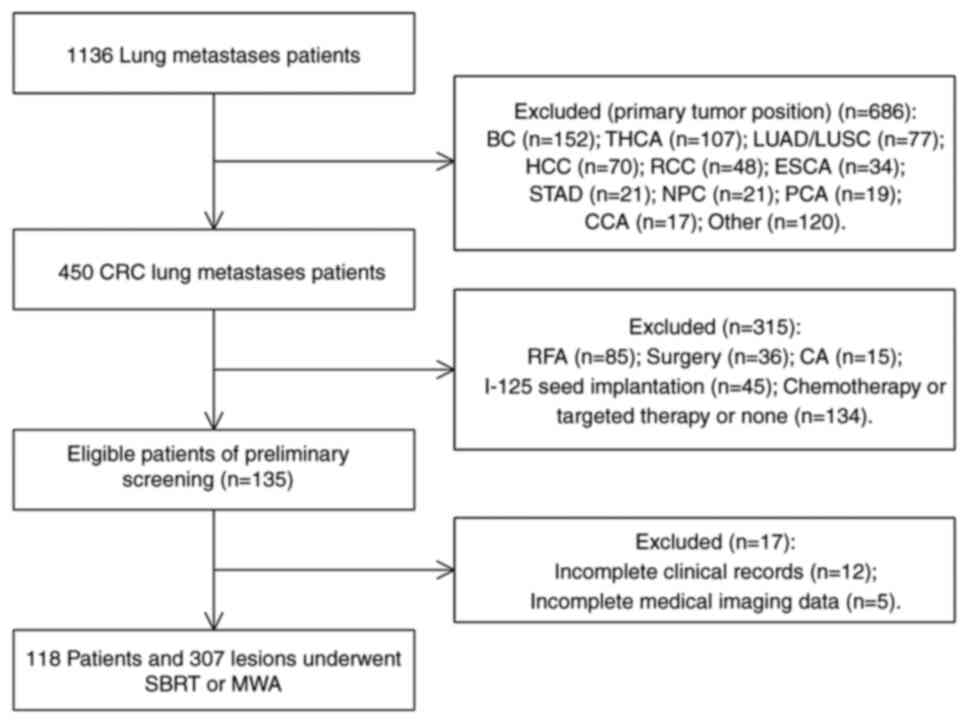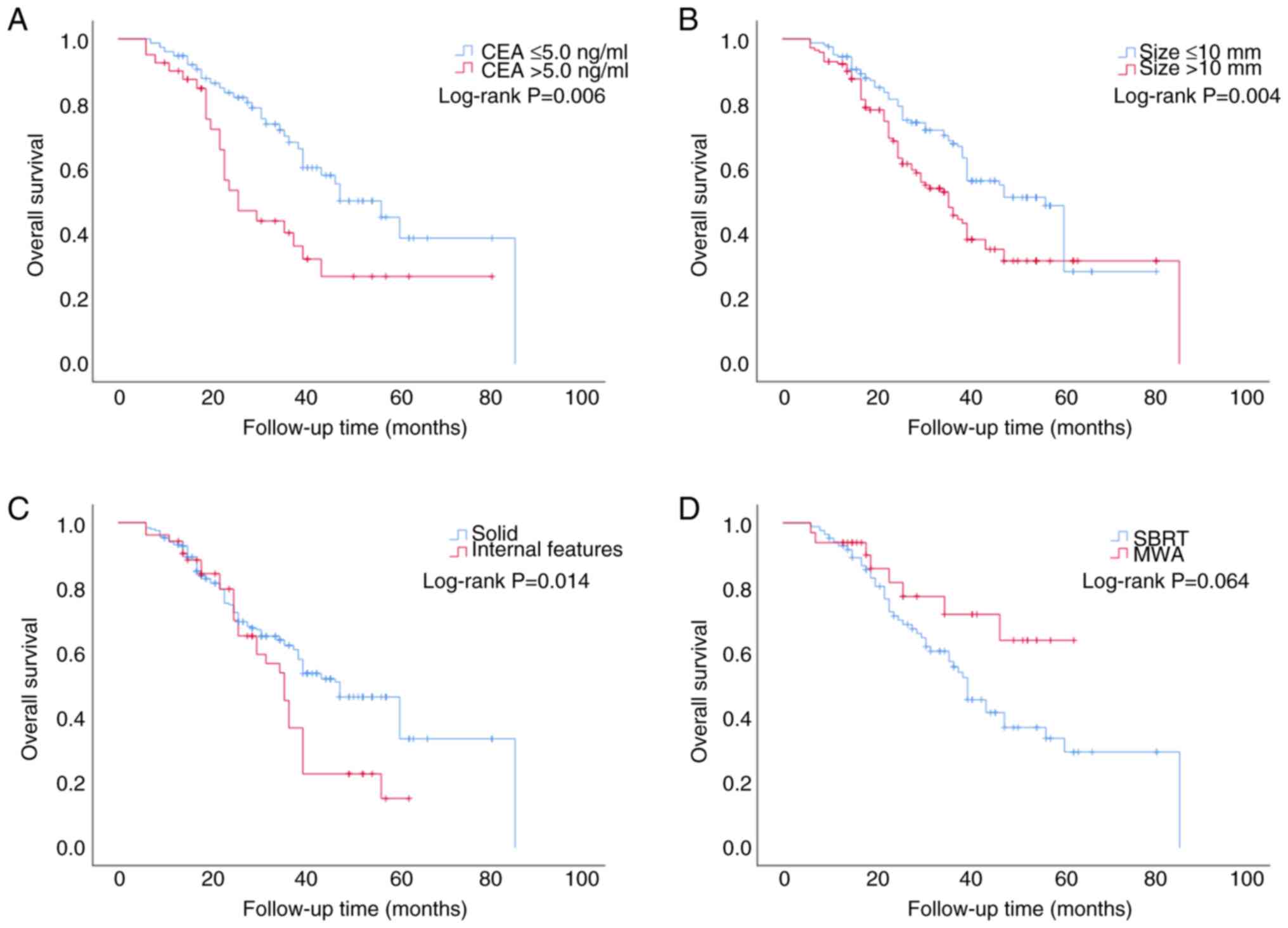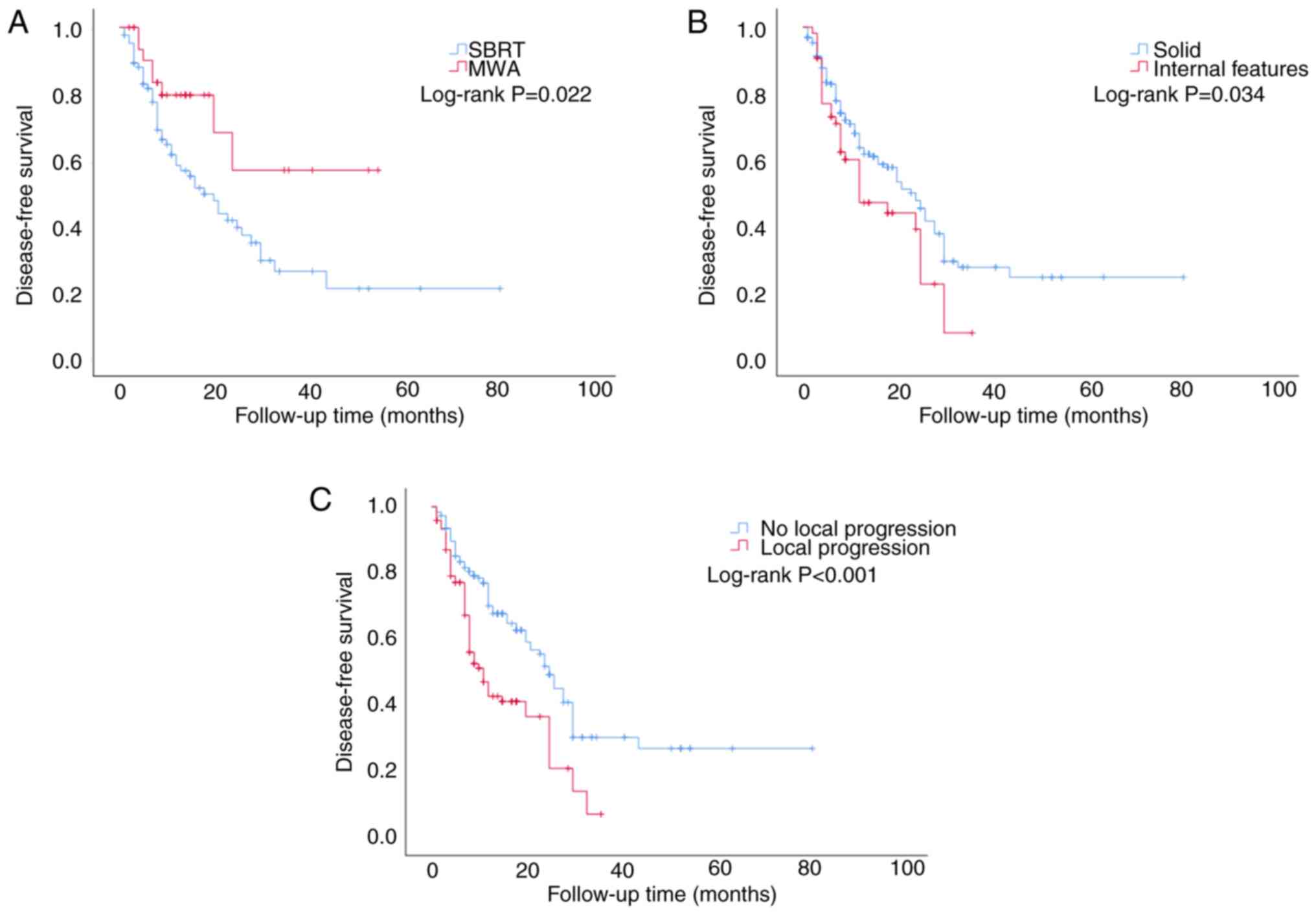|
1
|
Sung H, Ferlay J, Siegel RL, Laversanne M,
Soerjomataram I, Jemal A and Bray F: Global cancer statistics 2020:
Globocan estimates of incidence and mortality worldwide for 36
cancers in 185 countries. CA Cancer J Clin. 71:209–249. 2021.
View Article : Google Scholar : PubMed/NCBI
|
|
2
|
Van Cutsem E, Nordlinger B, Adam R, Köhne
CH, Pozzo C, Poston G, Ychou M and Rougier P; European Colorectal
Metastases Treatment Group, : Towards a pan-European consensus on
the treatment of patients with colorectal liver metastases. Eur J
Cancer. 42:2212–2221. 2006. View Article : Google Scholar : PubMed/NCBI
|
|
3
|
Riihimäki M, Hemminki A, Sundquist J and
Hemminki K: Patterns of metastasis in colon and rectal cancer. Sci
Rep. 6:297652016. View Article : Google Scholar : PubMed/NCBI
|
|
4
|
Siegel RL, Miller KD, Sauer AG, Fedewa SA,
Butterly LF, Anderson JC, Cercek A, Smith RA and Jemal A:
Colorectal cancer statistics, 2020. CA Cancer J Clin. 70:145–164.
2020. View Article : Google Scholar : PubMed/NCBI
|
|
5
|
Watanabe K, Saito N, Sugito M, Ito M,
Kobayashi A and Nishizawa Y: Incidence and predictive factors for
pulmonary metastases after curative resection of colon cancer. Ann
Surg Oncol. 20:1374–1380. 2013. View Article : Google Scholar : PubMed/NCBI
|
|
6
|
Zhang GQ, Taylor JP, Stem M, Almaazmi H,
Efron JE, Atallah C and Safar B: Aggressive multimodal treatment
and metastatic colorectal cancer survival. J Am Coll Surg.
230:689–698. 2020. View Article : Google Scholar : PubMed/NCBI
|
|
7
|
Cho JH, Kim S, Namgung M, Choi YS, Kim HK,
Zo JI, Shim YM and Kim J: The prognostic importance of the number
of metastases in pulmonary metastasectomy of colorectal cancer.
World J Surg Oncol. 13:2222015. View Article : Google Scholar : PubMed/NCBI
|
|
8
|
Wong SL, Mangu PB, Choti MA, Crocenzi TS,
Dodd GD III, Dorfman GS, Eng C, Fong Y, Giusti AF, Lu D, et al:
American society of clinical oncology 2009 clinical evidence review
on radiofrequency ablation of hepatic metastases from colorectal
cancer. J Clin Oncol. 28:493–508. 2010. View Article : Google Scholar : PubMed/NCBI
|
|
9
|
Ruers T, Van Coevorden F, Punt CJA, Pierie
JPEN, Borel-Rinkes I, Ledermann JA, Poston G, Bechstein W, Lentz
MA, Mauer M, et al: Local treatment of unresectable colorectal
liver metastases: Results of a randomized phase II trial. J Natl
Cancer Inst. 109:djx1502017. View Article : Google Scholar
|
|
10
|
Cheng G, Shi L, Qiang W, Wu J, Ji M, Lu Q,
Li X, Xu B, Jiang J and Wu C: The safety and efficacy of microwave
ablation for the treatment of CRC pulmonary metastases. Int J
Hyperthermia. 34:486–491. 2018. View Article : Google Scholar : PubMed/NCBI
|
|
11
|
Vogl TJ, Eckert R, Naguib NNN, Beeres M,
Gruber-Rouh T and Nour-Eldin NEA: Thermal ablation of colorectal
lung metastases: Retrospective comparison among laser-induced
thermotherapy, radiofrequency ablation, and microwave ablation. AJR
Am J Roentgenol. 207:1340–1349. 2016. View Article : Google Scholar : PubMed/NCBI
|
|
12
|
Lyons NJR, Pathak S, Daniels IR, Spiers A
and Smart NJ: Percutaneous management of pulmonary metastases
arising from colorectal cancer; a systematic review. Eur J Surg
Oncol. 41:1447–1455. 2015. View Article : Google Scholar : PubMed/NCBI
|
|
13
|
Yuan Z, Wang Y, Zhang J, Zheng J and Li W:
A meta-analysis of clinical outcomes after radiofrequency ablation
and microwave ablation for lung cancer and pulmonary metastases. J
Am Coll Radiol. 16:302–314. 2019. View Article : Google Scholar : PubMed/NCBI
|
|
14
|
Ferguson CD, Luis CR and Steinke K: Safety
and efficacy of microwave ablation for medically inoperable
colorectal pulmonary metastases: Single-centre experience. J Med
Imaging Radiat Oncol. 61:243–249. 2017. View Article : Google Scholar : PubMed/NCBI
|
|
15
|
Franzese C, Comito T, Toska E, Tozzi A,
Clerici E, De Rose F, Franceschini D, Navarria P, Reggiori G,
Tomatis S and Scorsetti M: Predictive factors for survival of
oligometastatic colorectal cancer treated with stereotactic body
radiation therapy. Radiother Oncol. 133:220–226. 2019. View Article : Google Scholar : PubMed/NCBI
|
|
16
|
Choi HS, Jeong BK, Kang KM, Jeong H, Song
JH, Ha IB and Kwon OY: Tumor control and overall survival after
stereotactic body radiotherapy a pulmonary oligometastases from
colorectal cancer: A meta-analysis. Cancer Res Treat. 52:1188–1198.
2020.PubMed/NCBI
|
|
17
|
Cao C, Wang D, Tian DH, Wilson-Smith A,
Huang J and Rimner A: A systematic review and meta-analysis of
stereotactic body radiation therapy for colorectal pulmonary
metastases. J Thorac Dis. 11:5187–5198. 2019. View Article : Google Scholar : PubMed/NCBI
|
|
18
|
Kobayashi N, Abe T, Noda S-E, Kumazaki Y,
Hirai R, Igari M, Aoshika T, Saito S, Ryuno Y and Kato S:
Stereotactic body radiotherapy for pulmonary oligometastasis from
colorectal cancer. In Vivo. 34:2991–2996. 2020. View Article : Google Scholar : PubMed/NCBI
|
|
19
|
Nicosia L, Cuccia F, Mazzola R, Ricchetti
F, Figlia V, Giaj-Levra N, Rigo M, Tomasini D, Pasinetti N,
Corradini S, et al: Disease course of lung oligometastatic
colorectal cancer treated with stereotactic body radiotherapy.
Strahlenther Onkol. 196:813–820. 2020. View Article : Google Scholar : PubMed/NCBI
|
|
20
|
Kraus KM, Bauer C, Feuerecker B, Fischer
JC, Borm KJ, Bernhardt D and Combs SE: Pneumonitis after
stereotactic thoracic radioimmunotherapy with checkpoint
inhibitors: Exploration of the dose-volume-effect correlation.
Cancers (Basel). 14:29482022. View Article : Google Scholar : PubMed/NCBI
|
|
21
|
Antonoff MB, Sofocleous CT, Callstrom MR
and Nguyen QN: The roles of surgery, stereotactic radiation, and
ablation for treatment of pulmonary metastases. J Thorac Cardiovasc
Surg. 163:495–502. 2022. View Article : Google Scholar : PubMed/NCBI
|
|
22
|
Hasegawa T, Takaki H, Kodama H, Yamanaka
T, Nakatsuka A, Sato Y, Takao M, Katayama Y, Fukai I, Kato T, et
al: Three-year survival rate after radiofrequency ablation for
surgically resectable colorectal lung metastases: A prospective
multicenter study. Radiology. 294:686–695. 2020. View Article : Google Scholar : PubMed/NCBI
|
|
23
|
Kurilova I, Gonzalez-Aguirre A, Beets-Tan
RG, Erinjeri J, Petre EN, Gonen M, Bains M, Kemeny NE, Solomon SB
and Sofocleous CT: Microwave ablation in the management of
colorectal cancer pulmonary metastases. Cardiovasc Intervent
Radiol. 41:1530–1544. 2018. View Article : Google Scholar : PubMed/NCBI
|
|
24
|
Yang X, Ye X, Zheng A, Huang G, Ni X, Wang
J, Han X, Li W and Wei Z: Percutaneous microwave ablation of stage
I medically inoperable non-small cell lung cancer: Clinical
evaluation of 47 cases. J Surg Oncol. 110:758–763. 2014. View Article : Google Scholar : PubMed/NCBI
|
|
25
|
Delpla A, de Baere T, Varin E, Deschamps
F, Roux C and Tselikas L: Role of thermal ablation in colorectal
cancer lung metastases. Cancers (Basel). 13:9082021. View Article : Google Scholar : PubMed/NCBI
|
|
26
|
de Baère T, Auperin A, Deschamps F,
Chevallier P, Gaubert Y, Boige V, Fonck M, Escudier B and
Palussiére J: Radiofrequency ablation is a valid treatment option
for lung metastases: Experience in 566 patients with 1037
metastases. Ann Oncol. 26:987–991. 2015. View Article : Google Scholar : PubMed/NCBI
|
|
27
|
Zheng A, Ye X, Yang X, Huang G and Gai Y:
Local efficacy and survival after microwave ablation of lung
tumors: A retrospective study in 183 patients. J Vasc Interv
Radiol. 27:1806–1814. 2016. View Article : Google Scholar : PubMed/NCBI
|
|
28
|
Wei Z, Ye X, Yang X, Huang G, Li W, Wang J
and Han X: Microwave ablation plus chemotherapy improved
progression-free survival of advanced non-small cell lung cancer
compared to chemotherapy alone. Med Oncol. 32:4642015. View Article : Google Scholar : PubMed/NCBI
|
|
29
|
Matsui Y, Hiraki T, Gobara H, Iguchi T,
Fujiwara H, Nagasaka T, Toyooka S and Kanazawa S: Long-term
survival following percutaneous radiofrequency ablation of
colorectal lung metastases. J Vasc Interv Radiol. 26:303–311. 2015.
View Article : Google Scholar : PubMed/NCBI
|
|
30
|
McKeown E, Nelson DW, Johnson EK, Maykel
JA, Stojadinovic A, Nissan A, Avital I, Brücher BL and Steele SR:
Current approaches and challenges for monitoring treatment response
in colon and rectal cancer. J Cancer. 5:31–43. 2014. View Article : Google Scholar : PubMed/NCBI
|
|
31
|
Perkins GL, Slater ED, Sanders GK and
Prichard JG: Serum tumor markers. Am Fam Physician. 68:1075–1082.
2003.PubMed/NCBI
|
|
32
|
Zhong W, Yu Z, Zhan J, Yu T, Lin Y, Xia
ZS, Yuan YH and Chen QK: Association of serum levels of CEA, CA199,
CA125, CYFRA21-1 and CA72-4 and disease characteristics in
colorectal cancer. Pathol Oncol Res. 21:83–95. 2015. View Article : Google Scholar : PubMed/NCBI
|
|
33
|
Li Q, Dai W, Li Y, Xu Y, Li X and Cai S:
Nomograms for predicting the prognostic value of serological tumor
biomarkers in colorectal cancer patients after radical resection.
Sci Rep. 7:463452017. View Article : Google Scholar : PubMed/NCBI
|
|
34
|
Nakagoe T, Sawai T, Tsujia T, Jibiki M,
Ohbatake M, Nanashima A, Yamaguchi H, Yasutake T, Ayabe H and
Arisawa K: Prognostic value of serum sialyl Lewis(a), sialyl
Lewis(x) and sialyl Tn antigens in blood from the tumor drainage
vein of colorectal cancer patients. Tumour Biol. 22:115–122. 2001.
View Article : Google Scholar : PubMed/NCBI
|
|
35
|
Sato T, Nishimura G, Nonomura A, Miwa K
and Miyazaki I: Serological studies on CEA, CA 19-9, STn and SLX in
colorectal cancer. Hepatogastroenterology. 46:914–919.
1999.PubMed/NCBI
|
|
36
|
Sharma A, Baker S, Duijm M, Oomen-de Hoop
E, Cornelissen R, Verhoef C, Hoogeman M and Nuyttens JJ: Prognostic
factors for local control and survival for inoperable pulmonary
colorectal oligometastases treated with stereotactic body
radiotherapy. Radiother Oncol. 144:23–29. 2020. View Article : Google Scholar : PubMed/NCBI
|
|
37
|
Zhang J, Yang F, Li B, Li H, Liu J, Huang
W, Wang D, Yi Y and Wang J: Which is the optimal biologically
effective dose of stereotactic body radiotherapy for Stage I
non-small-cell lung cancer? A meta-analysis. Int J Radiat Oncol
Biol Phys. 81:e305–e316. 2011. View Article : Google Scholar : PubMed/NCBI
|
|
38
|
Ager BJ, Wells SM, Gruhl JD, Stoddard GJ,
Tao R, Kokeny KE and Hitchcock YJ: Stereotactic body radiotherapy
versus percutaneous local tumor ablation for early-stage non-small
cell lung cancer. Lung Cancer. 138:6–12. 2019. View Article : Google Scholar : PubMed/NCBI
|
|
39
|
Nieuwenhuizen S, Dijkstra M, Puijk RS,
Geboers B, Ruarus AH, Schouten EA, Nielsen K, de Vries JJJ,
Bruynzeel AME, Scheffer HJ, et al: Microwave ablation,
radiofrequency ablation, irreversible electroporation, and
stereotactic ablative body radiotherapy for intermediate size (3–5
cm) unresectable colorectal liver metastases: A systematic review
and meta-analysis. Curr Oncol Rep. 24:793–808. 2022. View Article : Google Scholar : PubMed/NCBI
|
|
40
|
Franzese C, Comito T, Clerici E, Di Brina
L, Tomatis S, Navarria P, Reggiori G, Viganò L, Poretti D, Pedicini
V, et al: Liver metastases from colorectal cancer: Propensity
score-based comparison of stereotactic body radiation therapy vs
microwave ablation. J Cancer Res Clin Oncol. 144:1777–1783. 2018.
View Article : Google Scholar : PubMed/NCBI
|
|
41
|
Inoue Y, Miki C, Hiro J, Ojima E, Yamakado
K, Takeda K and Kusunoki M: Improved survival using multi-modality
therapy in patients with lung metastases from colorectal cancer: A
preliminary study. Oncol Rep. 14:1571–1576. 2005.PubMed/NCBI
|
|
42
|
Fan H, Xie X, Pang Z, Zhang L, Ding R, Wan
C, Li X, Yang Z, Sun J, Kan X, et al: Risk assessment of
pneumothorax in colorectal lung metastases treated by percutaneous
thermal ablation: A multicenter retrospective cohort study. Int J
Surg. 110:261–269. 2024. View Article : Google Scholar : PubMed/NCBI
|
|
43
|
Lu Q, Cao W, Huang L, Wan Y, Liu T, Cheng
Q, Han Y and Li X: CT-guided percutaneous microwave ablation of
pulmonary malignancies: Results in 69 cases. World J Surg Oncol.
10:802012. View Article : Google Scholar : PubMed/NCBI
|












